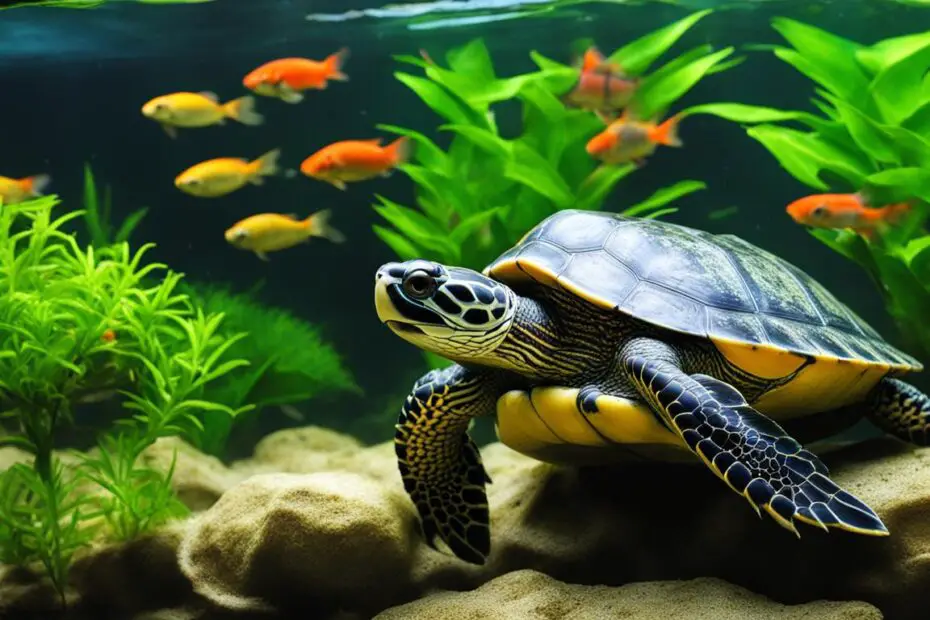Setting up a proper habitat is essential for the health and happiness of your aquatic turtle. Whether you’re a beginner or experienced turtle owner, it’s crucial to create an environment that meets their specific needs. From tank selection to accessories, every detail matters when it comes to ensuring your turtle’s well-being.
Key Takeaways:
- Research the specific needs of your turtle species to provide an optimal turtle habitat.
- Choose a tank designed to hold water with the appropriate size for your turtle’s growth.
- Consider filtration systems, heaters, and suitable substrates for the tank.
- Position the tank away from direct sunlight and provide proper lighting.
- Create a balanced environment with both land and water areas, incorporating rocks and logs for hiding and climbing.
With these guidelines, you’ll be able to set up a turtle tank that replicates the natural habitat and provides the perfect home for your aquatic turtle. Remember to regularly monitor and maintain the tank conditions to ensure the well-being of your beloved pet.
Choosing the Right Tank
When setting up a tank for your aquatic turtle, selecting the right tank is essential for creating a suitable habitat. Here are some key factors to consider:
- Tank Design: Choose a tank specifically designed to hold water to ensure it is leak-proof and durable. Glass tanks with a thickness of 6-10mm are recommended for their strength and transparency.
- Size: It’s important to select a tank that can accommodate your turtle’s future growth. Consider the adult size of your turtle species and provide ample space for swimming.
- Filtration System: A strong filtration system is crucial for maintaining water quality and removing waste. Invest in a reliable turtle tank filter that can handle the waste production of your turtle.
- Water Heater: Aquatic turtles require a consistent water temperature for their well-being. Install a turtle tank heater to ensure the water remains within the appropriate temperature range.
- Substrate: Choose a suitable substrate for the tank bottom, considering your turtle’s habitat preferences and ease of maintenance. Avoid using gravel that your turtle may mistakenly ingest.
To visualize these considerations, refer to the table below:
| Tank Considerations | Recommendations |
|---|---|
| Tank Design | Glass tank with a thickness of 6-10mm |
| Size | Adequate space for swimming and future growth |
| Filtration System | Invest in a strong turtle tank filter |
| Water Heater | Ensure a consistent water temperature with a suitable turtle tank heater |
| Substrate | Choose a suitable substrate for the tank bottom |

By carefully considering these factors when choosing a tank, you can provide a comfortable and healthy environment for your aquatic turtle.
Positioning the Tank
When setting up your aquatic turtle tank, it’s crucial to consider the positioning of the tank within your home. The location you choose should not only be able to support the weight of the tank but also provide the optimal conditions for your turtle’s health and well-being.
One important factor to keep in mind is the exposure to direct sunlight. Placing the tank near a window or in direct sunlight can lead to fluctuations in temperature and encourage algae growth. These conditions can be detrimental to your turtle’s health.
Proper lighting is essential for your turtle’s overall well-being. It’s important to provide both a basking light and a UVB light to ensure your turtle receives the necessary heat and UV radiation.
Proper lighting is crucial for your turtle’s health and well-being, as it helps regulate their body temperature and supports their calcium metabolism.
Turtle Tank Lighting Essentials
When it comes to turtle tank lighting, there are two key components to consider:
- Basking Light: A basking light simulates the sun’s heat and provides a warm spot for your turtle to dry off and regulate its body temperature. This light should be placed above the basking area, allowing your turtle to easily access it.
- UVB Light: UVB light is crucial for your turtle’s health as it helps them produce Vitamin D3, which is essential for calcium absorption and strong bones. This light should be positioned in a way that allows your turtle to receive adequate UVB radiation.
It’s important to invest in high-quality lights specifically designed for reptiles. These lights should be placed on a timer to ensure they provide a consistent day-night cycle for your turtle.
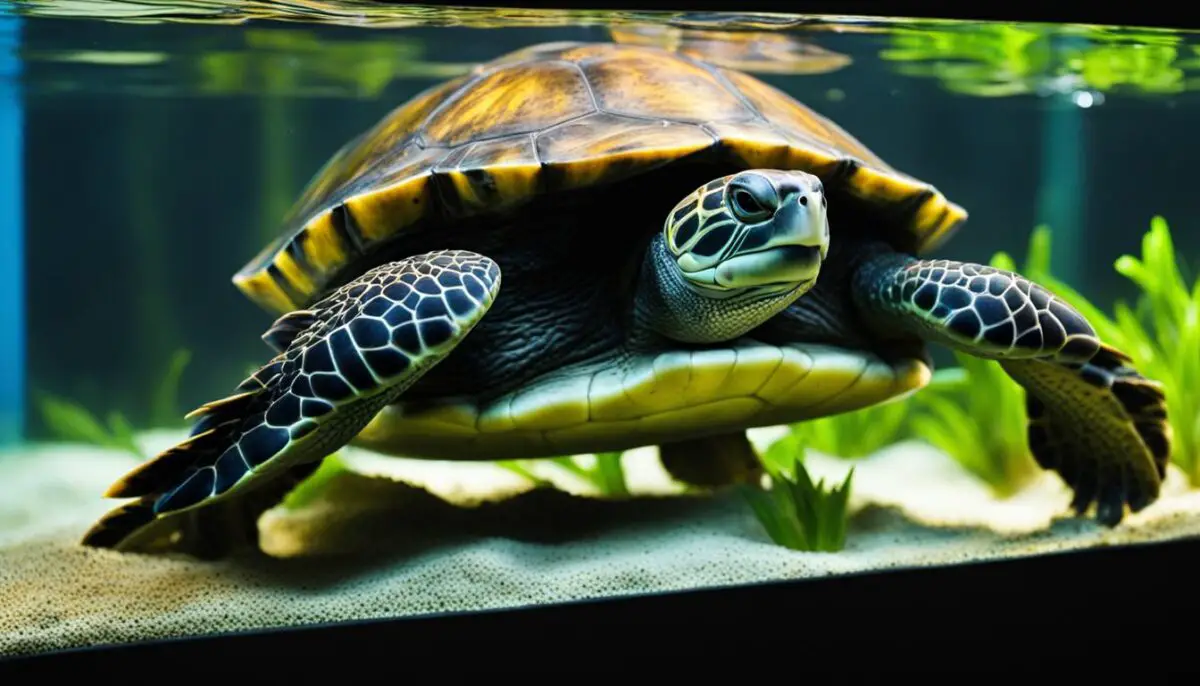
In addition to the lighting, it’s recommended to provide a hiding area for your turtle to retreat to when it wants to avoid the lights. This can be achieved by incorporating decorations such as rocks, logs, or plants.
By carefully considering the positioning of your turtle tank and providing the proper lighting, you can create a suitable and comfortable environment for your aquatic turtle.
Designing the Turtle’s Environment
Turtles require a well-designed tank environment that provides both land and water areas. It’s important to create a space where your turtle can swim, explore, and bask comfortably. In this section, we’ll discuss key considerations and tips for designing a suitable turtle habitat.
Water Level and Accessibility
The water level in your turtle tank should be deep enough to allow your turtle to swim and flip over freely. This ensures proper exercise and prevents any stress or discomfort. Be mindful of your turtle’s size and adjust the water level accordingly.
Basking Area Size and Placement
The size of the basking area will depend on your turtle’s species and its swimming or basking preferences. Some turtles prefer larger basking areas, while others may enjoy smaller platforms. Observe your turtle’s behavior to determine the ideal size and place the basking area in an easily accessible spot within the tank.
Choosing Decorations
Decorations play a crucial role in creating a stimulating and naturalistic environment for your turtle. Rocks, logs, and other turtle tank decorations provide hiding places, climbing opportunities, and areas for exploration. Make sure the decorations are safe, smooth, and non-toxic for your turtle.
Tip: Consider using underwater plants or artificial aquarium plants to add visual interest and improve the overall aesthetic of your turtle tank.
To give you a better idea of how to design your turtle’s environment, take a look at this visual example:
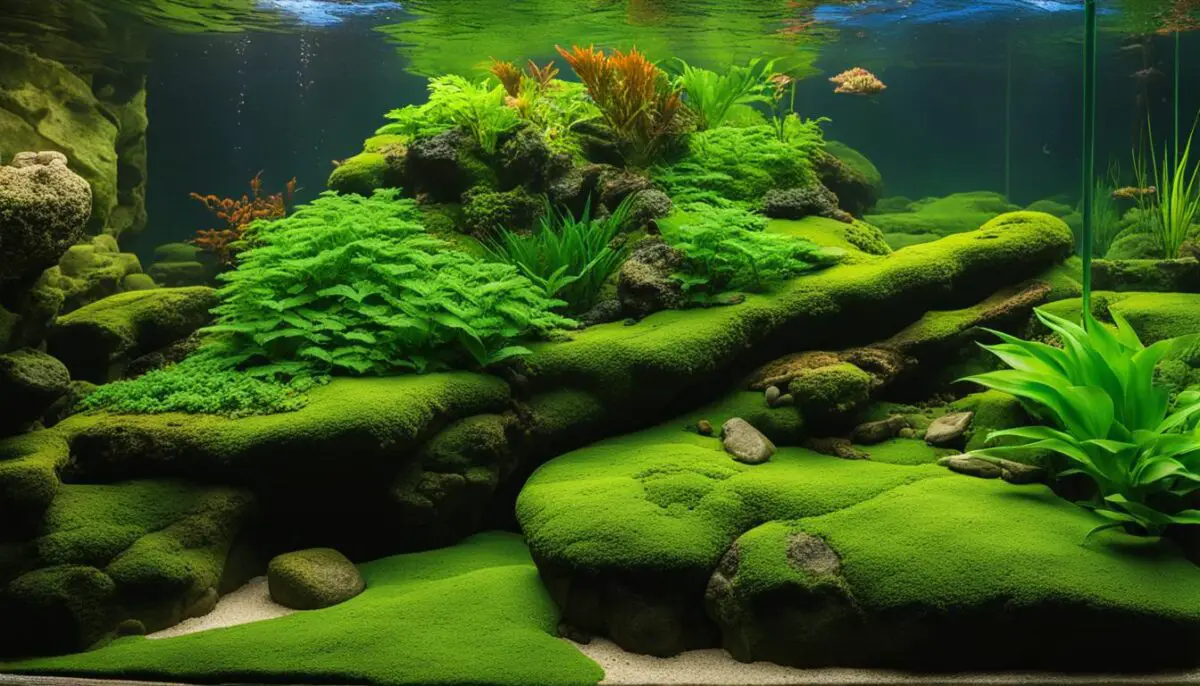 |
Image: Turtle Tank Decorations This image showcases a turtle tank with carefully chosen decorations, including rocks and logs, to create a natural and engaging habitat for the turtle. The decorations provide hiding spots and climbing opportunities, creating a visually appealing and stimulating environment. |
|---|
By incorporating these design elements into your turtle’s environment, you can provide a comfortable and enriching space for your aquatic companion to thrive.
Choosing a Basking Platform
A basking platform is essential for your turtle’s well-being, providing them with a designated area to dry off and absorb essential UV radiation. When selecting a basking platform, it is important to consider the size of your turtle to ensure they have adequate room to move comfortably. Let’s explore the different options available for the best turtle tank setup.
Floating Platforms
Floating platforms are a popular choice for turtle owners because they offer versatility and easy installation. These platforms can be adjusted to different water levels, allowing your turtle to find the perfect spot for basking. Additionally, floating platforms provide your turtle with the option to swim beneath it, mimicking their natural habitat.
Above-Tank Platforms
Above-tank platforms, also known as turtle docks, are another excellent option for creating a basking area. These platforms are designed to attach securely to the side of the tank, creating an elevated resting spot for your turtle. They often come with ramps that allow easy access to the water, catering to your turtle’s natural behavior.
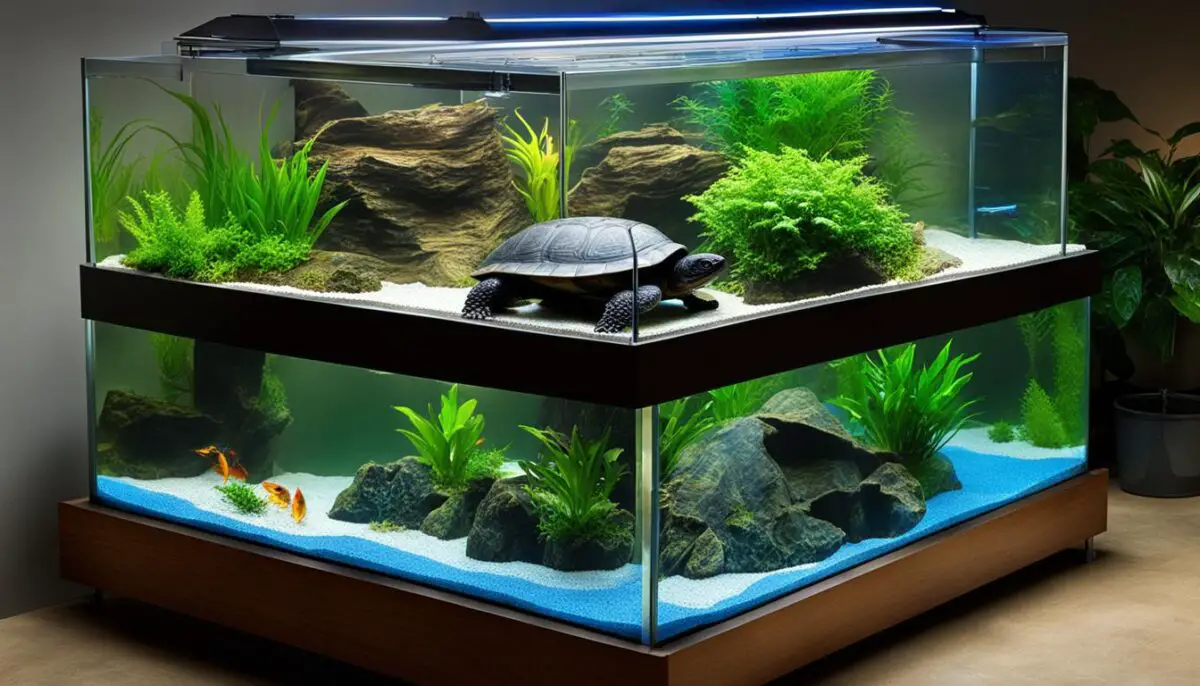
When choosing a basking platform, ensure that it is made of durable materials that can withstand constant exposure to water. It’s also crucial to select a platform with a textured surface to prevent your turtle from slipping and falling. This will minimize the risk of injuries and contribute to their overall safety and comfort.
Expert tip: Observing your turtle’s behavior and preferences can help you determine their preferred basking platform. Some turtles may prefer a larger platform that allows for more freedom of movement, while others may prefer a smaller, cozier spot. Consider providing multiple basking options to cater to different preferences and ensure your turtle’s happiness.
To create the best turtle tank setup, remember to position the basking platform near a heat lamp and a UVB light source. This will provide the necessary warmth and UV radiation that your turtle needs for their overall health and well-being.
Water and Basking Area Conditions
Maintaining proper water conditions is crucial for the health of your aquatic turtle. To ensure a clean and healthy environment, it is important to set up an effective filtration system. Investing in a strong external filter will help remove waste and debris from the water, keeping it clear and maintaining optimal water quality. Position the filter in a way that promotes proper water circulation throughout the tank.
Another important factor to consider is the temperature of the water. Aquatic turtles thrive in water that is consistently maintained at the appropriate temperature. A water heater is essential to regulate and maintain a suitable temperature range for your turtle. Research the specific temperature requirements of your turtle species and set the heater accordingly.
In addition to water conditions, providing adequate lighting is crucial for the overall well-being of your turtle. A basking light, positioned above the basking area, will provide the necessary heat for your turtle to regulate its body temperature. This basking light should be set on a timer to ensure consistent lighting cycles. Along with the heat, your turtle requires UVB light to support its calcium metabolism. Ultraviolet radiation aids in the synthesis of vitamin D, which is essential for the overall health and shell development of your turtle. Place a UVB light in a suitable fixture, ensuring that it is positioned within the recommended distance from the basking area.
To ensure that the conditions within the tank are optimal, it is crucial to monitor the temperature and humidity levels regularly. Use a thermometer to measure the water temperature and adjust the heater if necessary. A hygrometer will help you monitor the humidity levels within the tank, as maintaining an appropriate level of humidity is important for your turtle’s health.
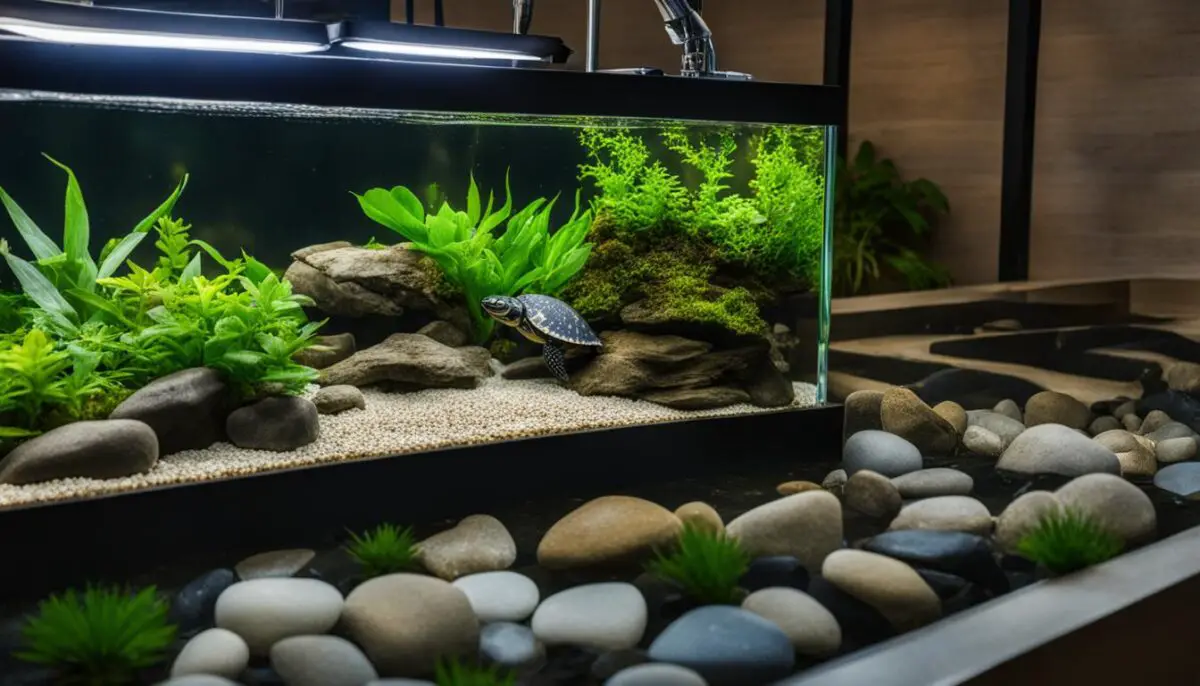
| Aspect | Action |
|---|---|
| Filtration | Invest in a strong external filter for effective waste removal and water circulation. |
| Water Temperature | Use a water heater to maintain the appropriate temperature range for your turtle species. |
| Lighting | Provide a basking light for heat and a UVB light to support your turtle’s calcium metabolism. |
| Temperature and Humidity Monitoring | Regularly monitor water temperature and humidity levels with a thermometer and hygrometer. |
Tank Cover and Decorations
When setting up your turtle tank, it is important to consider adding a tank cover and carefully selecting decorations that enhance your turtle’s habitat. Let’s explore the importance of tank covers and the various decorations available for your aquatic turtle tank.
Tank Cover
A tank cover is an essential accessory for your turtle tank. It serves two important purposes: preventing your turtle from escaping and protecting them from light-related accidents. Your tank cover should allow UVB rays to pass through while ensuring the safety of your turtle.
When selecting a tank cover, consider a sturdy option that fits securely on top of your tank. This will prevent your turtle from pushing it open or accidentally knocking it off. Additionally, ensure that the cover has sufficient ventilation to maintain proper airflow in the tank.
Avoid using materials such as mesh or wire that may injure your turtle’s delicate skin or limbs. Opt for a solid lid that provides a secure and safe enclosure for your aquatic friend.
Turtle Tank Decorations
Decorating your turtle tank not only enhances its visual appeal but also provides a stimulating and enriching environment for your turtle. Here are some popular turtle tank decorations to consider:
- Plants: Adding live or artificial aquatic plants creates a natural and calming atmosphere in the tank. Live plants offer additional benefits such as oxygenation and water filtration. Artificial plants, on the other hand, are low-maintenance and won’t be consumed by your turtle.
- Rocks and Caves: Providing rocks and caves in the tank allows your turtle to explore and find hiding spots. They also create climbing opportunities and add texture to the tank.
- Coral and Seashells: If you want to create an underwater theme, incorporating coral and seashells can give your turtle tank a vibrant and colorful look. Ensure that the coral is made from safe materials that won’t harm your turtle if accidentally consumed.
- Logs and Branches: Adding logs and branches provides your turtle with natural perches and basking spots. Make sure they are securely placed to avoid any risk of collapse or injury to your turtle.
Remember to periodically clean and inspect the decorations to remove any waste or buildup. This will help maintain a clean and healthy environment for your turtle.
By carefully selecting a suitable tank cover and incorporating the right decorations, you can create a comfortable and visually appealing habitat for your aquatic turtle. Consider your turtle’s species and behavior when choosing decorations to ensure they are safe and provide enrichment. Now that you have a better understanding of tank covers and decorations, it’s time to move on to the final section: Conclusion.
Conclusion
Setting up an aquatic turtle tank is a crucial step in ensuring the health and well-being of your turtle. With careful planning and consideration, you can create a suitable habitat that mimics their natural environment and allows them to thrive.
The key to a successful aquatic turtle tank setup lies in following the recommended guidelines for tank selection, positioning, environment design, water and basking area conditions, and tank accessories. By choosing the right tank size, incorporating proper filtration and heating systems, and providing a balanced environment with adequate lighting and basking areas, you can create the perfect habitat for your turtle.
Regular maintenance and monitoring of the tank conditions are essential for the long-term health of your turtle. This includes cleaning the tank, checking water parameters, and ensuring the temperature and humidity levels are within the appropriate range. By staying on top of these tasks, you can ensure the optimal health and well-being of your aquatic turtle.
FAQ
What factors should I consider when setting up an aquatic turtle tank?
When setting up an aquatic turtle tank, it is important to consider the specific needs of your turtle species. You should research the appropriate tank size and accessories, consult with an expert if needed, and ensure proper filtration, heating, lighting, substrate, and decorations.
What type of tank should I choose for my aquatic turtle?
It is recommended to choose a glass tank with a thickness of 6-10mm that is designed to hold water. The tank should have the appropriate size for your turtle’s future growth and provide enough space for swimming and basking.
What tank accessories do I need for my turtle?
Some essential tank accessories for turtles include a strong filtration system to handle waste production, a water heater to maintain the proper temperature, a suitable substrate for the tank bottom, and proper lighting, including a basking light and a UVB light for heat and UV radiation.
How should I position the turtle tank in my home?
When positioning the turtle tank, choose a location that can support the weight of the tank and avoid placing it near direct sunlight, as it can affect the temperature and encourage algae growth. Proper lighting is crucial, so ensure the tank is placed in an area where your turtle can receive adequate light.
What should I consider when designing the turtle’s environment?
Turtles require both land and water areas within their tank. The water level should be deep enough for swimming, and the basking area should be sized according to your turtle’s species and swimming or basking preferences. Choose decorations, such as rocks and logs, that provide hiding places and climbing opportunities for your turtle.
How do I choose a basking platform for my turtle?
When choosing a basking platform, consider your turtle’s size and ensure it has enough room to turn around comfortably. Floating platforms and above-tank platforms are popular options that provide space for both swimming and basking. Ensure the platform has a ramp for easy access to the water.
How do I maintain proper water and basking area conditions?
To maintain proper water conditions, invest in a strong external filter to handle waste production and a heater to maintain a constant water temperature. Adequate lighting with a basking light for heat and a UVB light for calcium metabolism is also essential. Use a thermometer and hygrometer to monitor temperature and humidity levels.
What should I consider for the tank cover and decorations?
A tank cover is essential to prevent your turtle from escaping and protect them from light-related accidents. Choose a cover that allows UVB rays to pass through while ensuring your turtle’s safety. When decorating the tank, choose plants and decorations that won’t impede your turtle’s movements and can be easily cleaned. Sturdy and large enough fake plants can be a low-maintenance option.
